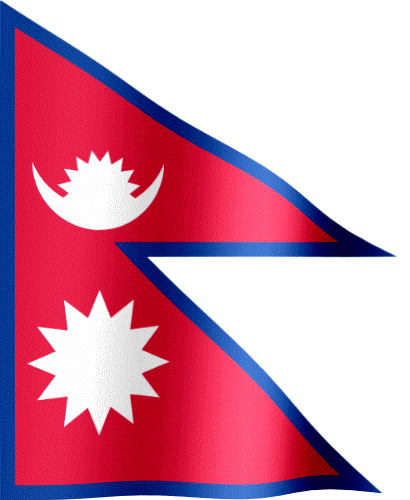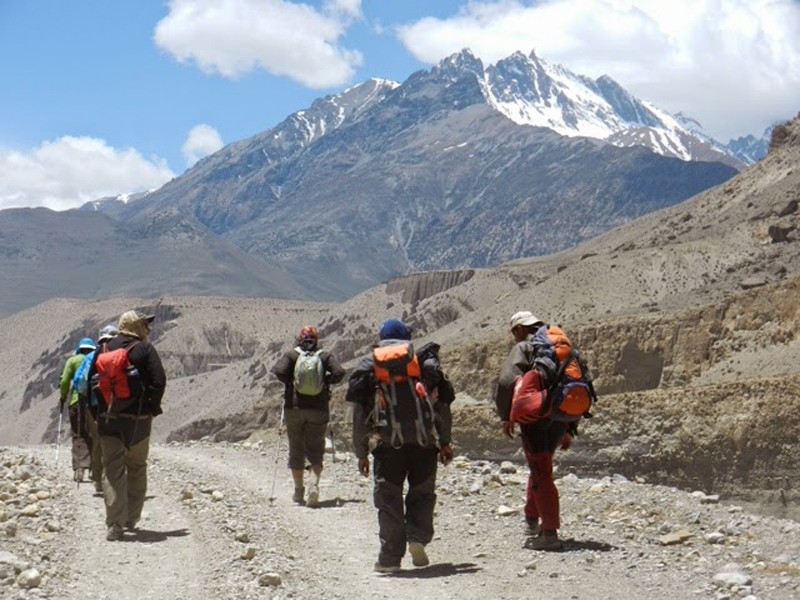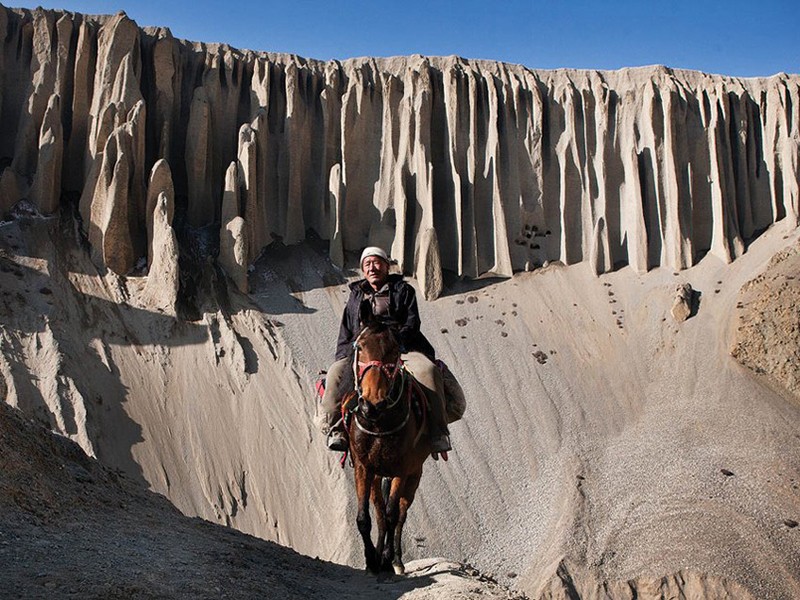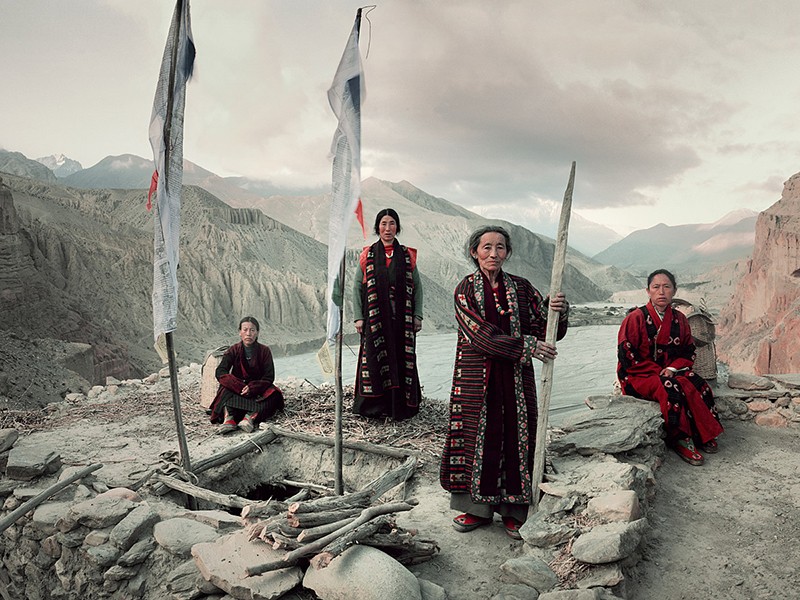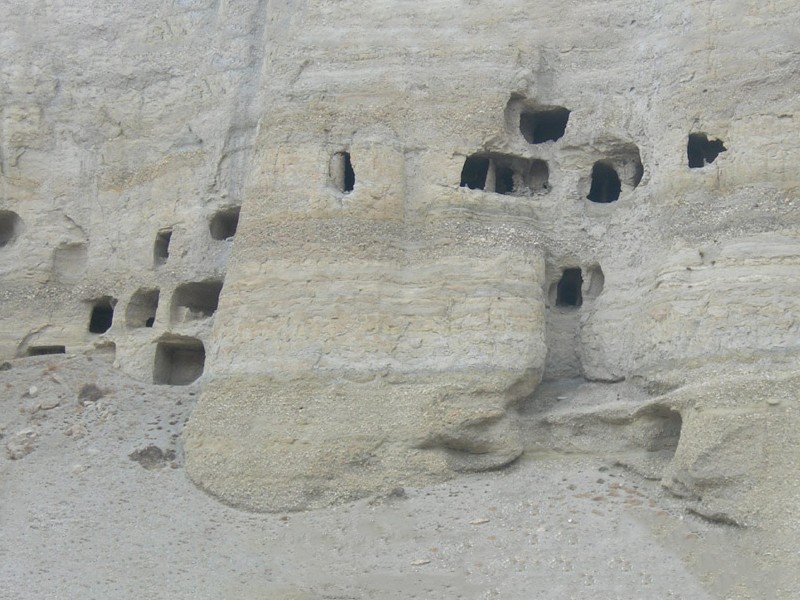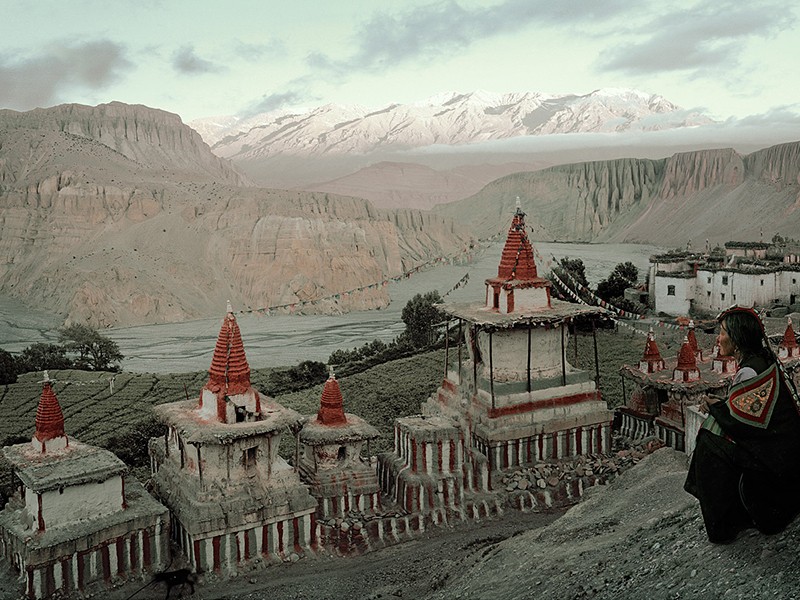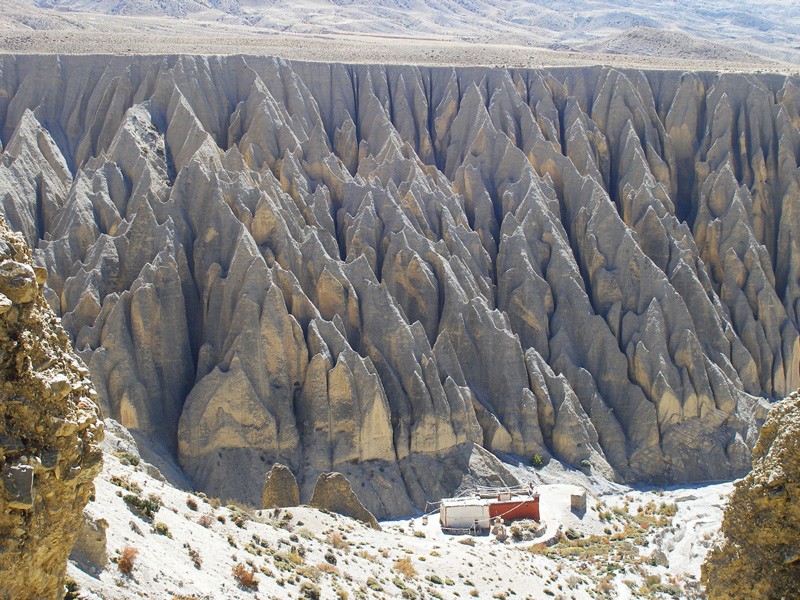Reference Code: RAUMTNP
Trip Start: Kathmandu
Trek Start: Jagat
Trek Days: 19 Days
Maximum Altitude: 5416m.
Age: 20-60 years
Season: Spring and Autumn
Accommodation: Lodge
Service: Full board
Destination: Nepal
Trip End: Kathmandu
Trek End: Jomsom
Trip Durations: 25 Days
Physical Rating: Strenuous
Group Size: 4-16 pax
Theme: Walking and observation
Meals: Standard
It is a combination trek of Round Annapurna and Upper Mustang Trek.
The Annapurna Circuit is a popular name for a trek within the Annapurna mountain range of central Nepal. The total length of the route varies between 160–230 km (100-145 mi), depending on where the motor transportation is used and where the trek is ended. The trek rises to an altitude of 5,416m. on the Thorung La pass, touching the edge of the Tibetan plateau. This trek crosses two different river valleys and encircles the Annapurna massif, crossing Thorung La (5416m), the highest pass on this trek. Practically all trekkers hike the route counter clockwise, as then the daily altitude gain is slower and crossing the high Thorong La pass is easier and safer.
The mountain scenery, seen at close quarters includes the Annapurna Massif (Annapurna I-IV), Dhaulagiri, Machhapuchhre, Manaslu, Gangapurna [7455m] and Tilicho Peak (7134m). Numerous peaks of 6000-8000m in elevation rise from the Annapurna range.
In March 1992, the 'forbidden' kingdom of Mustang was opened to the outside world. Now, for the first time in recent history, foreign travelers are able to visit La Manthang, the seat of an ancient kingdom dating back to the 15th century. The Kingdom of La is situated along the north central border of Nepal north of the main range of the Himalaya's in the upper reaches of Mustang District. Lo and the area directly to its south, called Baragaon, which both fall within Upper Mustang, can be claimed as one of the most outstanding areas of the Himalaya.
The people of Upper Mustang are called Bhotias and those from Lo are called Lobas. They speak various dialects of Tibetan. Historically, their art and culture flourished due to contact with traders, monks and religious masters passing between Tibet and India, or between Ladakh and Bhutan.
The climate and geography of Upper Mustang are nearly identical to those of Western Tibet and as such, they are dramatically different from the temperate and tropical areas of the south side of the Himalayas. The dry, wind swept ecology of this Trans-Himalayan region is extremely fragile. Fuel wood is virtually non-existent, water is scare, the agricultural land yields insufficient food grains and the marginal and grasslands support only limited numbers of livestock and wildlife. With the influx of tourists, the already pressured desert environment risks further degradation.
In addition, although the culture has flourished in contact with other religious and cultural centers of the Himalayas, its sudden exposure to other worlds beyond its high plateau may create a negative impact on the society. Hence still the government of Nepal has kept this area under restricted area in order to keep the destructive environmental and cultural impact of tourism in Upper Mustang to an absolute minimum. the Ministry of Tourism has decided to develop the area as a model eco-tourism area.
Day 01 Arrival in Kathmandu(1350m.)
Namaste! And welcome to Kathmandu, the colourful capital of Nepal where ornately carved balconies mingle with beautiful shrines and temples. Your adventure begins with a welcome meeting on arrival at the exit gate of Kathmandu airport. Our staff will welcome you and pick you to your accommodated hotel. Please seek our company palmplate to find our staff at the main exit gate of the airport. Rest of the day you can relax at the hotel or short evening walk around local market on your own as per your wish.
drive 45 mins
Day 02 Rest and preparation day
A well deserved rest day at cosy of hotel after a long tiring flight. This day, one can move around nearby local market to purchase or hire trekking equipment that is necessary for the trekking like sleeping bags, walking sticks etc, exchange currency as requirement or simply walk around in the local market or Kathmandu Durbar squire nearby with small entrance fee as per your preference on your own. Evening at the hotel lobby there will be pre-trip briefing in which you will be introduced with your trekking guide and explained about your trip in short, instruction for safety etc.
Day 03 Drive to Besisahar(760m.) and to Jagat(1300m.)
This morning, drive to Besisahar (approximately 5.5 hours) to immediately immerse yourself in the spectacular mountain wilderness that encompasses the Annapurna Range. After reaching Besisahar, we will have quick lunch. At this place we have to submit our trekking permit to enter inside Annapurna Conservation Area Project site. After permit clarance we will change vehicle and drive with 4WD to Jagat which will take 3 and half hours more. The road is quite bumpy and rough. After reaching Jagat, we will check into a lodge.
Drive:9 hours
Day 04 Trek to Dharapani(2100m.)
Today’s trek continues through the deep wooded canyon embellished by stunning waterfalls. We’ll be venturing into the Manang district of the mountain range, with much of the trail ascending throughout the day.
7 hrs
Day 05 Trek to Chame(2710m.)
Marking the end of the great Marsyangdi Gorge, make a steep climb to Timang, then the trail settles into gentler slopes as the vegetation transforms from dense pine forests to drier slopes. The district headquarters of Manang, Chame, is the largest settlement after Besisahar.
6hrs
Day 06 Trek to Pisang(3300m.)
A slew of breathtaking scenery is on the cards today as the trail goes through a deep gorge, then past the great sweeping slope of Paungi Danda. Today is mostly an easy walk with few ascending stretches of trail dotted throughout the day.
5 hrs
Day 07 Trek to Manang Village(3540m.)
Trek the northern trail via upper Pisang and Ghyaru – an area renowned for its spectacular views. It is now drier and you are sure to come across local farmers herding yaks. Here’s a hot tip – Tibetan yaks take a special interest in people wearing red, so choose your gear carefully today!
6 hrs
Day 08 Acclimatization day
Spend a day here to acclimatise by doing some high climbing, then return to the lower altitude of Manang for the night. Manang, a village of about 500 flat-roofed houses, offers excellent views of Annapurna II, Annapurna III, Gangapurna and Chulu East.
Day 09 Trek to Yak Kharka(4018m.)
Covering approximately 7 kilometres, today will be a steadily uphill climb into the alpine region of the mountain range. We’ll arrive at Yak Kharka, ready for an easier day of trekking tomorrow to acclimatise to the high altitude.
5 hrs
Day 10 Trek to Phedi(4450m.)
Due to the altitude, feel free to take the next section of the climb at a leisurely pace, meaning you’ll have time to admire the magnificent views from this part of the route. Once at Phedi, there will be plenty of time to rest and acclimatise to the higher elevations ready for the next part of the climb where you will encounter the Thorung La Pass – the highest point on this Annapurna Explorer.
5 hrs
Day 11 Trek to Muktinath(3800m.) by crossing Thorung La(5416m.)
Setting off very early to cross the Thorung La Pass (5416 m), the trail is steep but easy to follow. After between 4 to 6 hours climbing, reach the Pass's peak, adorned with prayer flags, a traditional stupa (chorten) and stone cairns built by travellers. Stop to admire the stunning views and marvel at how far you've climbed. Further along, the trail descends steeply proceeding towards Chabarbu. From here on, the trail crosses meadows, drops into a deep ravine, climbs out and follows a wide trail into Muktinath – a pilgrimage site held in great reverence by both Hindu and Buddhist populations.
8-9 hrs
Day 12 Trek to Chhuksang(2920m.)
After breakfast, we resume our trek walking on a flat route towards Lo Mangthang, in the vicinity of Mukinath temple. We now trail downhill and then cross a suspension bridge. The trail then makes a fair ascent for about 30 minutes and gets flatter until we reach Gyu La Pass (4030 m). This is almost a vantage point to behold the mountainous vista of Mt. Dhaulagiri, Tukche peak, Thapa peak, Dhampus peak, Thorong peak, Mt. Tilicho etc. We now descend and cross couple of suspension bridges over small rivers and finally reach Chhuksang, a settlement dominated by Buddhists; around 200 of them live here with agriculture and business as their main occupation.
5-6 hrs
Day 13 Trek to Samar(3150m.)
Trekking from Chhuksang to Samar, we can vividly notice varying topography and the subsequent change in the culture and life patterns of the people. As we move ahead, the villages are sparse and small. We head north and cross the steel bridge over the roaring Kali Gandaki River. Once we make a steep climb up the rocky alley, we arrive at the village of Chele. Continuing our ascent along the side of a steep canyon, we now arrive at a pass and from here, we descend on a pleasant trail to Samar. This place is nothing less than an oasis for the mule and horse caravans.
5-6 hrs
Day 14 Trek to Geling(3510m.)
We start our day making a climb above Samar to a ridge, followed by a descent to a gorge past a chorten, getting us to a valley embellished with shady juniper trees. Moving ahead, we cross a stream and make an ascent to a pass and then walk down the ridge, which gets us to Shyangmochen, a sparse settlement with a handful of teashops. From here, we proceed with a gentle climb and emerge to yet another valley. Making a short descent from the valley, we finally arrive at Geling.
5-6 hrs
Day 15 Trek to Tsarang(3620m.)
From Geling, the trail climbs gently through fields of barley and groves of poplar trees up the center of the valley and then passes below the settlement of Tama Gaun and an imposing chorten. After rejoining the direct trail, it becomes a steep slow climb across the head of the valley to the Nyi La pass at 3973 m. From here, we make a long yet gentle descent to Tsarang, a maze of fields, willow trees and houses separated by stone walls at the top of the large Tsarang Cho canyon. The huge five storey white dzong and red gompa are perched on the edge of the Kali Gandagi gorge to the east end of the valley.
5-6 hrs
Day 16 Trek to Lo Mangthang(3730m.)
Today we'll trail down some 100 meters and cross the Charang Cho canyon. We then move slowly but steadily up a rocky trail to a cairn on a ridge opposite to the village at 3609 m. The trail turns north and climbs gently to a large isolated chorten that marks the boundary between Charang and and Lo Manthang. After a short recess, we travel across a desert-like landscape toned in grey and yellow and finally arrive at Lo Manthang, a city of whitewashed walls, with an admirable expanse of fields, almost swarmed with horses and yaks.
4-5 hrs
Day 17 Exploration day
Since we’ve been walking for almost a fortnight now, a rest day is well deserved. Let’s explore the capital of the ex-Mustang Kingdom. We can either stroll around beholding the intimate alleyways and courtyards of the city or rent a horse and ride to some of the other villages in the vicinity. There are lots to see in Lo Manthang. Tungchen Gompa, Champa Lakhang (God House), Chodi Gompa and the Royal Palace of the Mustang, are some of the sites worth visiting. Overnight at teahouse in Lo-Manthang
Day 18 Decent trek to Ghami(3590m.)
On our way to Ghemi, it would be unjustified to miss out Lo Gekar, a home to Ghar Gompa, the oldest Vajrayana monastery in the Himalaya. The trail to Lo Gekar is not a main trading route and is crisscrossed with herders’ trails. So our local guide is particularly useful here in order to identify the way ahead. In today’s trek, we will be crossing several lush green as well as barren valleys, including the Marang La pass (3291 m). We make a long rocky descent down a ravine to a grassy valley, where Lo Gekar is situated, within a cluster of large trees by a stream. Lo Gekar, meaning “Pure Virtue of Lo,” is also known as Ghar Gompa, or "House Temple”. We then continue ahead and pass by the magnificent Mani walls and chortens. Crossing the alpine meadows, we make a steep descent on the eroded alley and arrive at Dhamkar, our lunch spot. After lunch, we ambulate along the beautiful valley followed by a quick climb to a ridge, from where we descend to Ghemi.
5-6 hrs
Day 19 Trek to Samar(3150m.)
The moment we kiss goodbye to Ghemi, we embark on a constricted path and continue thereon until we reach Geling. We then cross a small stream and finally arrive at Samar, a village that literally emanates the Tibetan way of life.
5-6 hrs
Day 20 Trek to Kagbeni(2800m.)
Trek from Samar to Kagbeni is frequented by descents. We trail along a downhill route and arrive at Chhuksang. Crossing the suspension bridge over the roaring Kali Gandaki river, we continue walking along the bank of the river relishing the view of apple orchards and natural vegetation alongside, until we finally get to Kagbeni, a typical, stone built Mustang village. Its history dates back to the 14th century when it was formed as a check post for traders of Nepal and Tibet. This checkpoint still exists and is in operation, controlling the groups departing towards Muktinath and Mustang. It is also the main entry/exit point to the restricted area of Upper Mustang. The village has a monastery, a Police check post and ACAP (Annapurna conservation area project) office.
6-7 hrs
Day 21 Trek to Jomsom(2750m.)
Trek from Kagbeni to Jomsom is fairly flat and along the riverbed. We trail along the banks of Kali Gandaki and pass through the settlement of Eklebhatti before we finally arrive at Jomsom. The last trek and the shortest one of course. Evening we will celebrate the success of this trip along with all Nepalese staffs.
3-4 hrs
Day 22 Fly to Pokhara(820m.)
We take an early morning flight to Pokhara. The airplane passes through a gorge between Annapurna and Dhaulagiri mountains making the flight itself an amazing experience. After arriving in Pokhara, we can spend the rest of the day in leisure.
Fly 22 min drive 30 min
Day 23 Exploration day
Pokhara city offers vast activities and there is always be something to everyone from tranquality lover to extreme adventure seekers. A well deserved rest day after the trek is worthful in Pokhara and rest with the cozy of hotel on the shadow of most beautiful peak Mt. Machhapuchhere. Morning you can enjoy boating in Fewa Lake which is the most popular activities to all the visitors to Pokhara and evening you can roam around the local market. However, it also provides Zip flyers, ultra light flight over Annapurna Range, Para Glyding etc. Further there are many popular places like Rupa Lake, Begnas Lake, Bindabasini Temple, Davi's fall, Mahendra Cave, Bat Cave, International Mountain Museum in short distance where you can visit and observe the beauty of Pokhara Valley.
Day 24 Fly to Kathmandu(1350m.)
After breakfast, we say goodbye to the beautiful northern skyline of Pokhara and fly towards Kathmandu. After reaching Kathmandu, we take a rest or do some souvenir shopping.
Drive 30 min Fly 25 min
Day 25 Final departure
We say 'Namaste' for memories that will last a lifetime. There are no activities planned for today and you are able to depart the hotel at any time. Check out time from the hotel is at 12 noon. If you are departing later, you can arrange luggage storage at the hotel. For your final departure, our staff will pick you up from the hotel and transfer to Kathmandu airport approximately 3 hours prior to your international flight time.
Drive: 45 min
Inclusion
All ground transportation as per itinerary
3 night hotel accommodation in Kathmandu with B/B plan.
3 night hotel accommodation in Pokhara with B/B plan
TIMs (Trekking Information Management system) card
Annapurna Conservation Area Entry Fee
Special Restricted Area permit fee
Domestic flight with airport tax: KTM-PKH-JOM-PKH-KTM
Food for the member during the trek( 3 meals a day as per lodge open menu)
Lodge accommodation on twin sharing basis
Medical supplies(First aid Kit will be available)
All required Nepalese staffs (salary, food, clothing, accommodation)
All Nepalese staffs insurance as per Nepalese Government rules
Company service charge and government taxes etc.
Exclusion
International flight with airport tax.
Nepalese Entry Visa feeFood during stay in Kathmandu and Pokhara
All personal equipment and personal expenses
Photography Charges, Monument charges and Monument entry fees
Personal Medical and travel insurance(must cover helicopter rescue evacuation cost)
Personal Medicine
Telephone and internet charges
Laundry charges
Alcoholic beverage, bottled drinks and cold drinks during the trip
Rescue evacuation charges if required
Staff and porters Tips...
Equipment List
Clothing and Equipments List
» Pack to pack out - bring enough waterproof bags to carry all non-biodegradable rubbish back down the mountain.
» Remove all unnecessary packaging before leaving home.
» Bring enough warm dry clothes so that you can wrap up rather than burn firewood in the evenings.
» If you are going to trek higher than 5000m or you know it will be cold, buy an aluminum water bottle which can also be used as a hot water bottle at night.
» The easiest way to keep hydrated while trekking is to buy a 1 x liter platypus-drinking bladder to carry in your day pack.
» Make sure to buy proper trekking socks. Don’t buy synthetic socks as these promote sweating and can give you blisters. Always carry a few blister pads in your first aid kit and keep them handy in your day pack.
» Walking poles are very useful while trekking and helpful when descending.
» Please remember that waste disposal and recycling facilitates are limited in Nepal. When buying batteries make sure they are rechargeable and/or high quality so they last longer, and take them home to recycle.
More Lists
There is no definitive list. What you bring will vary according to the area, time of year and the length of your trek. Below is a suggested check list which you should adapt to your own needs. Ask yourself: Will there be snow/how long /high is the trek/are we camping?
» Good quality trekking boots with ankle support
» Lightweight shell/raincoat with hood
» Detachable fleece liner or separate fleece
» Fleece trousers
» Shorts and / or convertibles trousers- quick drying
» Sunglasses
» Sun hat and warm hat(good quality)
» Gloves
» Spare T-shirt x 3
» Sweat towel x 2
» Spare socks x 3 ( walking sock and thin inner sock)
» Small day sack
» Sun cream
» Small water bottle aluminum doubles as a hot water bottle.
» Iodine or water purifying kit,
» Soluble vitamin tablets to taste water or powder fruit drink
» Talcum powder
» Walking sticks or Trekking poles(good quality)
» Camp shoes/trainers/flip flops to wear in evening.
» Spare underwear 3
» Toilet kit
» Tissues
» Pen knife
» Bum bag
» Head torch(good quality)
» Biodegradable washing liquid / soap
» FILM
» CAMERA
» Ear plugs
» Sleeping bag liner(good quality)
» Sleeping bag(good quality-30)
» Bin bag/ gasbag to keep kit dry
» Small towel
» Lip balm
» Available in KTM
Personal First Aid (Aids Kit)
» Antiseptic
» Bandages
» Blister plasters
» Decongestant
» AMS medication like Diamox
» Eye drops – it can get very dusty on trails
» Paracetamol and/or ibuprofen
» Rehydration sachets, Imodium and antibiotics for traveler’s diarrhea
» Scissors
» Sterile dressing
» Sticking plasters and tape
» Throat lozenges / sweets
» Tweezers
» A sewing needle etc.
This trekking equipment list has been prepared by Adventure Zambuling Treks (P) Ltd.

